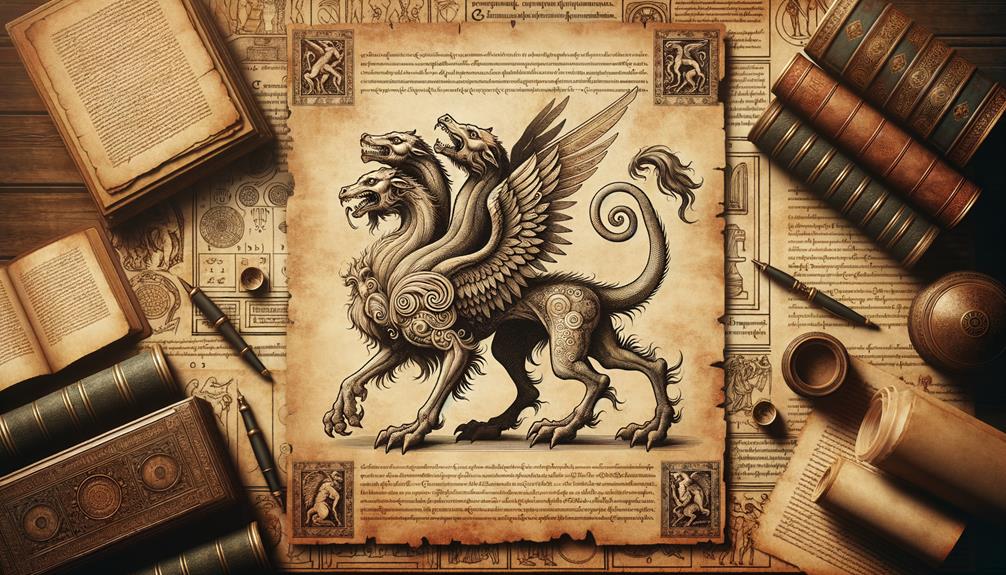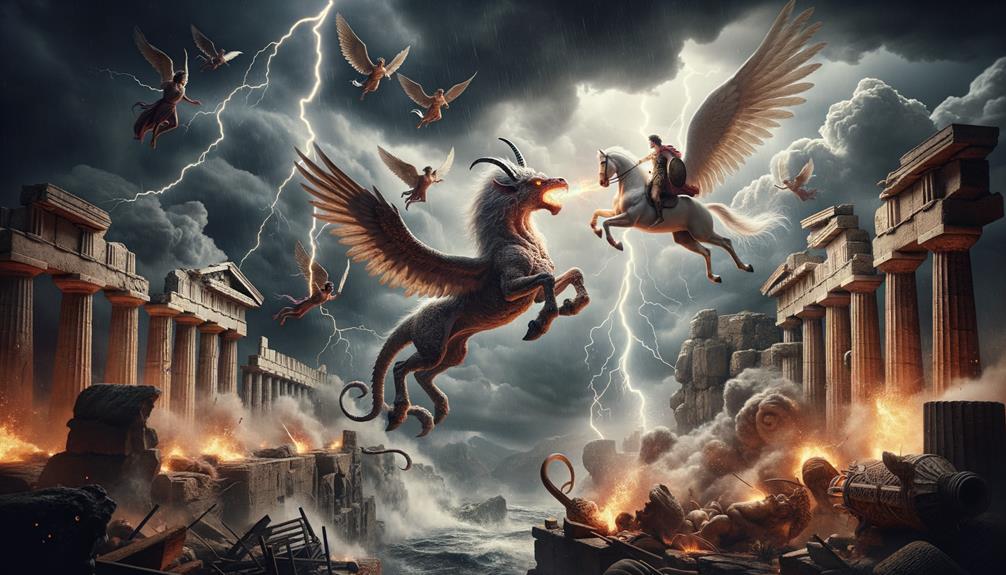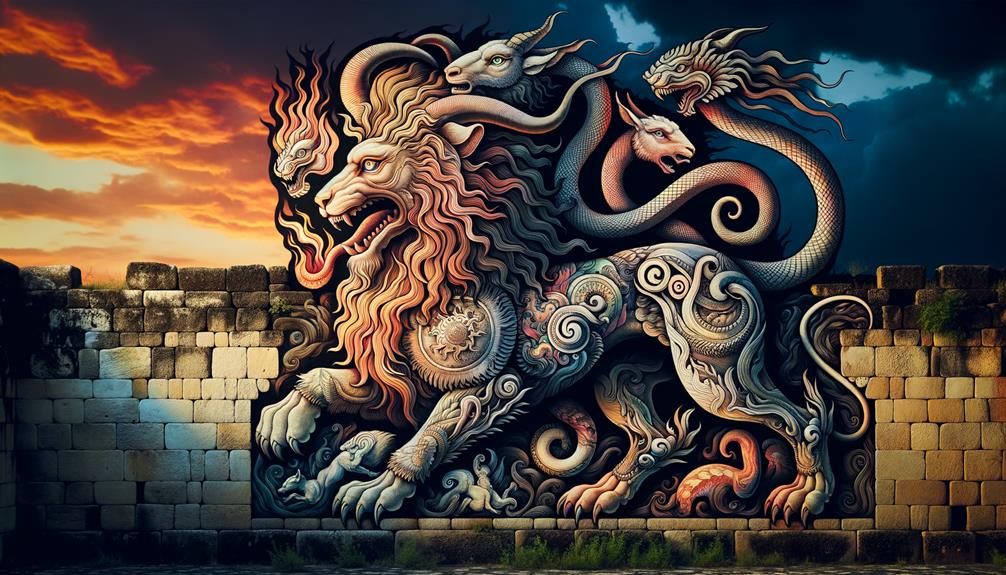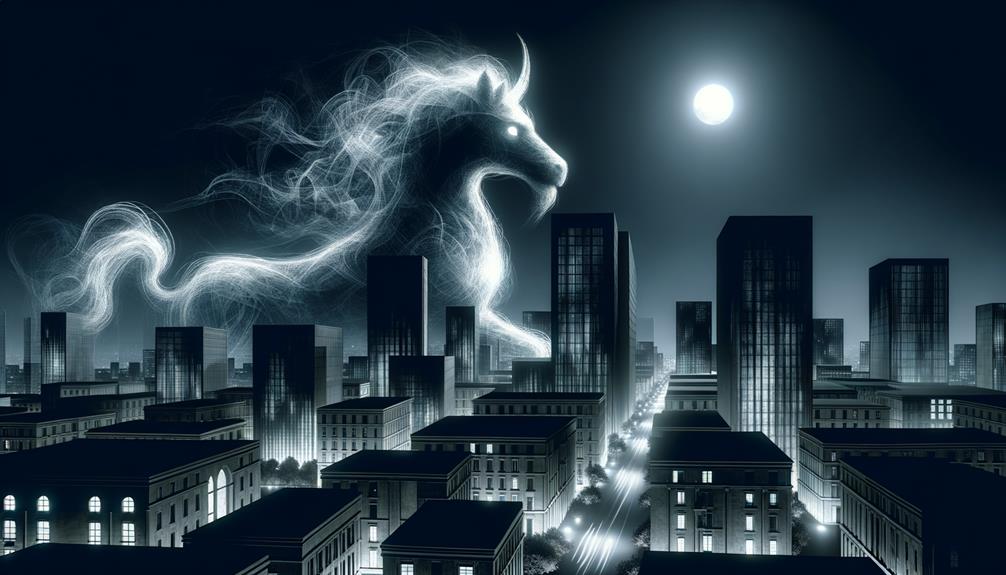While studying the detailed designs on old Greek pottery, I noticed the picture of a Chimera. This strange but interesting beast, combining aspects of lion, goat, and snake, has been a source of both fear and fascination for people across hundreds of years in the world of myths. The Chimera, as an emblem of the unimaginable — a fearsome mix of unrelated creatures — stirs up thought-provoking discussions about our fascination with the idea of mixed beings, change, and fear of the unfamiliar. As we go deeper in this discussion, we'll learn more about the many layers of meaning the Chimera carries, not only as a mythical beast but also as a symbol with cultural and psychological implications that has stood the test of time. Ready to step into the world where myths and symbols intertwine?
The Mythological Origin of Chimera

The Chimera is a creature straight from the pages of ancient mythology, often depicted with the head of a lion, the body of a goat, and the tail of a serpent. It's believed this terrifying creature was born from Echidna, while the identity of the father remains a mystery – it could be Typhon, Hydra, or maybe even Ceto. The Chimera is no ordinary monster. It represents the power of a lion, the toughness of a goat, and the slyness of a serpent. It's a key figure in many tales from ancient Greece.
There's a famous story about the Greek hero Bellerophon, who, with help from the winged horse Pegasus, managed to defeat the Chimera. The fiery breath of the Chimera, once feared by all, was silenced by Bellerophon, solidifying his reputation as a legendary hero. But the influence of the Chimera isn't limited to Greece. You can also find this creature in ancient Egyptian, Etruscan, and Neo-Hittite art, showing its wide-reaching appeal and impact.
As someone who studies ancient myths, I find the Chimera absolutely intriguing. Just imagine, a creature so terrifying, yet so captivating, that it leaves a mark on various cultures. This probably shows our collective fascination with hybrid creatures that blend contrasting qualities. The Chimera is a perfect example of how we react to the unknown – with a mix of fear and fascination.
In the context of the Chimera, we see a merging of different traits and characteristics. This monster represents a blend of the familiar and the unknown, which is often a source of both fear and fascination for us. This is a common theme in our engagement with the mythical and the monstrous. I hope this exploration helps us better understand why we're so drawn to these narratives of hybrid creatures and what they represent in our collective imagination.
Chimera's Role in Ancient Literature

Let's chat about the Chimera's vital role in ancient literature. It's quite a character, acting as a petrifying symbol of combined strength and a trial of bravery for heroes like Bellerophon. Picture this creature: a three-headed monster, deeply rooted in Greek mythology, often standing for disorder, devastation, and seemingly unbeatable challenges.
You'll find the Chimera in Etruscan works too, where it's a scary, fire-spitting beast, underscoring its image as a potent and terrifying symbol. The Greek poet Homer and the Homeric Hymns offer vivid portrayals of this creature, adding to its frightful image in literary tradition.
Let's run down some key points:
- The Chimera posed a serious challenge for the hero Bellerophon, pushing his bravery and power to the limit.
- The Chimera's defeat after a bitter battle symbolizes the victory of goodness over wickedness.
- The Chimera's influence in ancient literature wasn't just limited to Greece. It left its mark on other cultures and literary traditions as well.
Bellerophon's Encounter With Chimera

Let's take a closer look at the legendary face-off between the Greek hero Bellerophon and the beastly Chimera. The story begins with the king of Lycia, who, distressed by the monstrous Chimera, asks Bellerophon to defeat it. Mounted on Pegasus, Bellerophon charges into the sky, a scene often depicted in the arts as a symbol of courage bolstered by divine help.
The Chimera, a monstrous offspring of Typhon and Echidna, embodies chaos and destruction. It is a horrifying blend of snake, goat, and lion. The winged horse, Pegasus, renowned for wisdom and bravery, was instrumental in this epic clash.
Let's break down the symbolism:
| Bellerophon & Chimera | Symbolism | Representation |
|---|---|---|
| Bellerophon on Pegasus | Bravery & divine help | Artistic imagery |
| The fearsome Chimera | Chaos & destruction | Literary references |
| The clash | Victory over chaos | Cultural tales |
The narrative is more than a simple tale. Its rich symbolism and representation in various forms of art and literature have given it a timeless appeal. The courage of Bellerophon, the chaos of the Chimera, and the triumph of good over evil are themes that continue to resonate.
Artistic Depictions of Chimera

Chimera, a fascinating creature with the head of a lion, body of a goat, and tail of a serpent, has a long-standing presence in art history. This tri-headed beast's depiction goes all the way back to early mythological visuals, where it stood as a symbol of chaos and the monstrous.
The Chimera made its art debut during the Orientalizing period of Greek art. It's often shown in a heated fight with the hero Bellerophon. This was a strategic move by King Iobates who sent Bellerophon to kill the Chimera, a feat thought to be impossible. This tale is a common sight on ancient Sicyonian coins and diverse pieces of Greek pottery.
When it comes to the Chimera in art, you'll often see:
- Its three animal components, which highlight its frightening and unnatural features.
- Scenes with various Gods and Goddesses, underscoring its place in mythology.
- The Chimera acting as a guardian, a terrifying figure at the entrance of palaces or tombs, indicating both its protective and destructive sides.
Through these depictions, the Chimera has not only been cemented in our cultural consciousness but also recognized for its symbolic power. It's moved beyond its mythological roots to become a lasting representation of the monstrous and the unknown.
Chimera's Influence on Modern Culture

The Chimera's impact on today's culture is seen everywhere. From video games to sci-fi, from architecture to the words we use daily, the Chimera's influence is far-reaching. The ancient Greek tales of the Chimera are often used to breathe life into mythical creatures in present-day stories. You can see a fascination for the monstrous, like the Chimera, in popular series such as Star Wars and The X-Files.
But the Chimera's effects are not just in the arts. The term 'chimera', originating from Greek art, has slipped into our everyday speech, used to talk about something that's imaginative or not real. Despite initial reluctance, this word is now commonplace, showing our continuous fascination with the mythical.
Turkey, where these myths were born, acknowledges this legacy. As mentioned in the Dictionary of Classical Mythology by John F. University Press, the symbolism of the Chimera has been widely used in architecture, adding a touch of fantasy to our buildings. This adoption shows the ongoing importance of these ancient myths and their consistent effect on our culture today.
Frequently Asked Questions
How Is a Chimera Killed in Mythology?
So, you know how Bellerophon, with a little help from his winged partner Pegasus, took down the Chimera? This wasn't just any creature; we're talking about a fire-breathing monster here! But our hero didn't back down. Thanks to his courage and Pegasus' unique abilities, Bellerophon was able to defeat this formidable beast.
How Did Chimaera Mythology Become Reality?
While the myth of the Chimera hasn't exactly come to life, it has certainly made its mark on our culture and science. Take, for instance, the term 'chimeric' in genetics. This word, derived directly from the Chimera myth, is used to describe organisms composed of varied genetic material – just like the mythical beast itself. So, you see, myths have a way of influencing reality, even if it's in unexpected ways.
When Did the Chimera First Appear in Stories?
You know what's interesting? The Chimera, a mythical beast from the olden times of Greece, was a bizarre fusion of a lion, serpent, and goat. Homer and Hesiod, two iconic figures from that era, were the ones who gave us this fascinating description. Isn't mythology just full of intriguing creatures like this?
What Is an Interesting Fact About Chimera?
You know what's fascinating about the Chimera? It's not just a creature from mythology, but a symbol of the unbridled might of nature. The ancient Greeks didn't just see it as a monster, but as a representation of the unpredictable and intimidating forces of the natural world. It's quite the symbol, wouldn't you agree?

